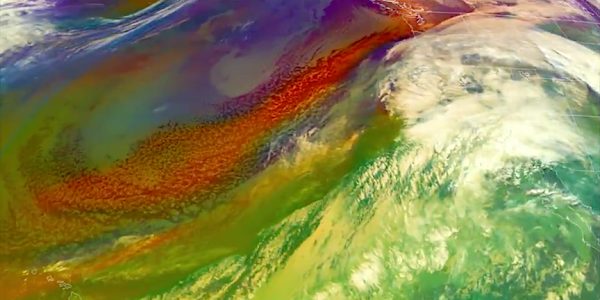
This phenomenon, known as an atmospheric river, brought more snow to northern California in a day than parts of New England have seen all winter. Redding, a city in California's Central Valley, got more than 13 inches of snow.
#Redding, California (at ~500 ft elevation in the far northern Sacramento Valley, where snow of any magnitude is rare) has now received more snow *in the past 12 hours* than #Boston, Massachusetts has received *this entire winter.* #CAwx #MAwx https://t.co/gvQG5e6mP5
— Daniel Swain (@Weather_West) February 13, 2019
A winter weather advisory remains in effect for Southern California through noon Saturday with expectations of more rain and around 1 inch of snow. Snow and rain will likely continue soaking the state throughout the weekend. The National Weather Service is also warning of possible flash floods in the region.
The current storm system is not a Pineapple Express, an atmospheric river that originates over Hawaii (hence "pineapple"). Instead, it originated a bit further south and east of Hawaii, so it doesn't get to share the same branding. (Last year, two Pineapple Expresses made stops in California.)
Satellite imagery of the storm system impacting the West with a moisture tap past Hawaii. Warmer air continues to move in from the southwest today for our region. #idwx #orwx pic.twitter.com/uZ9Iu2w2NN
— NWS Boise (@NWSBoise) February 14, 2019
However, the mechanism behind the Pineapple Express and the current atmospheric river is similar. Such rivers occur when plumes of moisture over the Pacific Ocean start to mesh with a larger storm system. Sometimes years can go by without an atmospheric river, and sometimes several can occur in a single season.
A massive volume of precipitation soaking the West Coast all at once can be dangerous. On Wednesday, Sacramento broke a daily rainfall record with a 1.6-inch downpour over 24 hours. The prior record was 1.22 inches. There are also mandatory evacuations in Orange County.
As Capital Weather Gang reported Friday, "Palomar Observatory, located on a mountaintop 60-plus miles north-northeast of San Diego, took in 10.1 inches of rain - its wettest day ever recorded. Palm Springs posted 3.68 inches, its wettest February day on record and the third heaviest 24-hour rainfall in any month."
Effective immediately, OCSD has issued an Evacuation Order (Mandatory) for the private residents within Trabuco Creek. Hard road closures are in effect at Trabuco Canyon at Rose Canyon and Trabuco Canyon at Plano Trabuco. No traffic is allowed past these road closures. pic.twitter.com/BVIIHorvJh
— OC Sheriff, CA (@OCSheriff) February 14, 2019
A key concern for California right now is mudslides. After back-to-back years of expansive, record-breaking wildfires, many areas of the state are denuded of the vegetation that would ordinarily anchor the soil in place. But even areas that haven't seen fires recently are vulnerable. Sausalito, California, saw five inches of rain in the past 24 hours, which triggered a mudslide in the hilly Bay Area town and forced people to evacuate at least 50 homes.
The National Weather Service is expecting more than seven inches of precipitation in Southern California and the Sierra Nevada through Saturday, as a new storm system rolls in.



Reader Comments
to our Newsletter